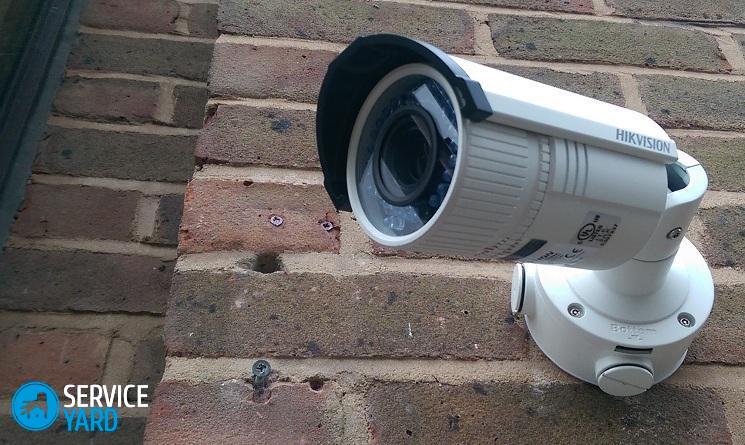Install video surveillance
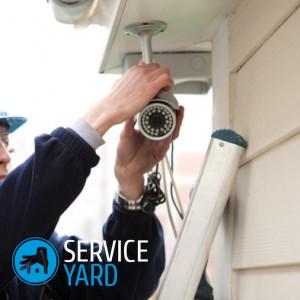
Any resident of a country house or apartment may be faced with the need for security of their housing. Video surveillance, which has remote control, is an essential element of a security system. Many residents want to install video surveillance on their own in order to save money. To do this, you must not only own the tool and have experience working with electrical equipment, but also understand the characteristics of the components.
to contents ↑Video surveillance in the apartment
Of the main issues that a home master will necessarily face, the following can be distinguished:
- The choice of video surveillance system.
- Correct installation of video cameras.
- Selection of component parts according to their technical parameters.
When choosing a type of video surveillance, you should definitely give preference to digital equipment, since such systems have powerful functionality and are easily integrated into the Internet, which allows you to control them remotely.
Important! Since pure analog video surveillance has long ceased to exist, a better option is to use more budget analog cameras connected to a digital video recorder.
Very often, the organization of domestic video surveillance systems occurs using a laptop or personal computer as the base device. Such systems are easy to install and, depending on the software, capable of performing many different actions.
One camcorder can be connected directly to a PC via a USB connector, and to connect several cameras you will have to install video capture cards on your computer. First of all, installing video surveillance will require the correct placement of cameras.
to contents ↑Selection of equipment and installation sites
When choosing points for installing video cameras, special attention must be paid to avoid the presence of “dead zones” in which part of the space is out of sight. There are several simple rules for installing video surveillance, which you must follow, since improper placement of cameras significantly reduces the reliability of the entire system:
- The choice of places for installation of surveillance cameras is made on the layout plan.
- In an apartment where there are no long corridors, you should use wide-angle cameras.
- Cameras should not be very visible.
- To avoid flare, you should not orient the cameras to the windows of an apartment or house.
- All mounting wires must be hidden.
Using the plan of a house or apartment, you can avoid many mistakes when arranging the placement of cameras:
- First of all, cameras should be focused on penetration points - windows, doors, attic hatches.
- To lock the windows, you should not orient the cameras to the street, it is better to place them a little to the side so that the sun's rays do not illuminate the picture.
- Also, do not direct the cameras at any lighting devices.
Important! The cameras should be installed at an inaccessible height, and all wires must be hidden after installation. The use of wide-angle video cameras will make it possible to reduce their number, since with a well-positioned one camera can capture a large amount of space, including doors and windows.
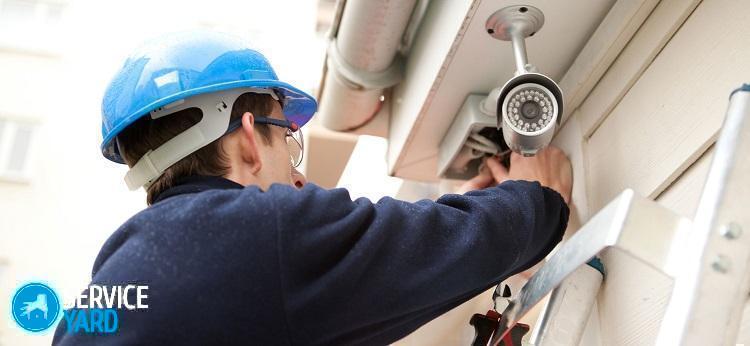
CCTV in a private house
If you need to install DIY video surveillance for a private house, you must provide for the mandatory installation of external all-weather cameras that control the area near the house.
What is required for video surveillance:
- A set of video cameras.
- Source of power.
- Recorder with internet access or computer.
- Mounting wires.
If you plan to install wireless surveillance, then the need for mounting wires and a power supply for video cameras disappears by itself. For a home video surveillance system, a monitor is also not needed, as the owners of a private house or apartment are controlled remotely via the Internet.
Such remote video monitoring makes it possible to monitor children, as well as elderly or sick relatives. If there is no need for constant video surveillance, then you should buy and install video cameras that are equipped with motion sensors.
Important! In addition, when such sensors are triggered, the system warns the owners of the house about unauthorized entry into the housing and can signal an alarming quick response group.
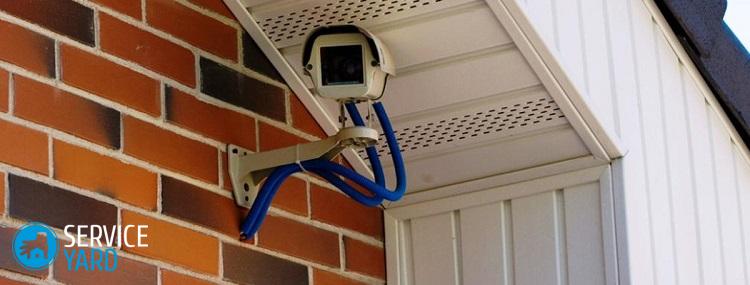
The camera is the backbone of the system
The main element of any surveillance system is the camera. It is from its characteristics that the reliability and quality of video surveillance depends.
Important! Of course, for an ordinary apartment it’s not necessary to buy “Lux” class cameras with very high resolution and detail, which cost quite a lot of money, however, it’s also not worth saving on housing safety.
The main parameters of video cameras include the following:
- Resolution.
- Sensitivity.
- The angle of the lens.
- The ratio of the useful signal to noise.
When choosing a camera, the following should also be taken into account:
- The sensitivity unit of video cameras is Lux (lx). This parameter determines the minimum level of illumination, under which the camera will broadcast a fairly distinguishable picture. So, the sensitivity of the camcorder of 0.01 lux will make it possible to see the image of the night landscape even on a moonless night.
Important! In home video surveillance systems, as a rule, cameras with a sensitivity of 0.05-0.1 lux are used.
- Resolution determines the ability to recognize even the smallest details of a picture. Resolution is measured in television lines (TVL). For video surveillance choose cameras with a resolution of about 420-480 television lines. As a rule, the number of pixels is indicated in the technical passport of the product, however, this parameter is quite subjective, since it depends on the size of the CCD matrix, which is rarely indicated.
Important! If you focus on the number of pixels, then when choosing a camera, you should pay attention to the model with a resolution of about 3 megapixels. Values of 16-20 megapixels for such cameras are nothing more than an advertising move.
- In addition to the useful signal, any camera is capable of generating a noise signal, the value of which should be as small as possible, since it clogs the main signal with itself. Noise on the monitor display will be visible as snow or ripples.
- The viewing angle is also very important, because it determines the controlled area of the territory or premises. This parameter depends on the focal length, as well as the size of the photosensitive sensor. It is worth knowing that the smaller the focal length, the larger the capture area.
Important! There are cameras used in video eyes that give a viewing angle of 120 degrees. They are capable of capturing a large area, but the image can turn out to be very distorted, especially at the edges, which is why they are not used in video surveillance systems.
- As additional parameters of the camera, its dimensions and the value of the supply voltage can also be considered. To organize a video surveillance system, in addition to cameras, you will also need a personal computer and a DVR, a mounting wire and fasteners, and, of course, do not forget about various programs for smartphone and computer.
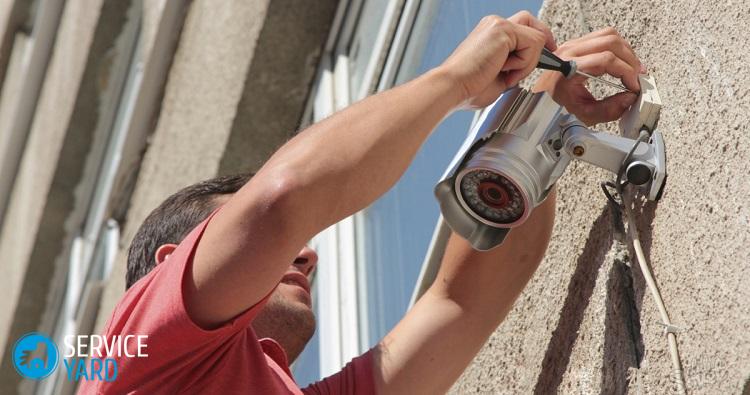
CCTV system installation
To install video surveillance yourself, you need to know some of the nuances, from which the following can be distinguished.
Tip 1
The type of cable that will be used in the installation process must be determined according to the principle of the video surveillance system.
Analog camera models are reliable and low price, so they are often used at home. Video surveillance installation with cameras of this type is best done with the help of a domestic KVB cable, which can be for both indoor and outdoor use. Such a cable is convenient in that in its design it contains a 75 ohm coaxial line for organizing video signal transmission and two conductors for supplying power to video cameras.
Important! If you have a personal computer and just one video camera is enough, then you can use a USB camera that connects to a similar connector on the device using a connecting cable with a length of not more than five meters.
Tip 2
If digital cameras are not one, but several, and a universal recorder is used instead of a computer, then a UTPCat 5e 2X2X0.52 cable containing two twisted pairs of copper single-core wire should be used to connect the cameras. So, a video stream of digital information will be broadcast on one pair, and power will be supplied on the other.
Tip 3
As a rule, the camcorder comes with a swivel bracket that is rigidly mounted on the wall and makes it possible to select the desired camera viewing angle with great accuracy. So, choosing a place for mounting the camera, you need to focus on the minimum length of the connecting wires, as well as the ability to hide all lines.
Tip 4
When connecting analog video cameras, it is worth paying special attention to cutting the coaxial cable, as well as connecting the BNC connectors, since the most common cause of system crashes and failures is connected with poorly made connections of individual elements.
to contents ↑Stock footage
As you can see, installing video surveillance on your own is not difficult for those who know the basics of electronics and are able to work with the tool. Otherwise, you should turn to specialists, since the safety of your home will depend to some extent on the quality and reliability of the installation of equipment.
- How to choose a vacuum cleaner taking into account the characteristics of the house and coatings?
- What to look for when choosing a water delivery
- How to quickly create comfort at home - tips for housewives
- How to choose the perfect TV - useful tips
- What to look for when choosing blinds
- What should be running shoes?
- What useful things can you buy in a hardware store
- Iphone 11 pro max review
- Than iPhone is better than Android smartphones



